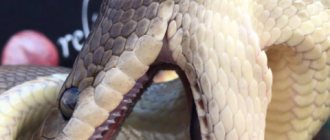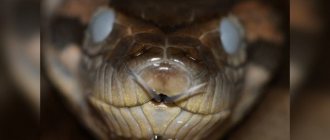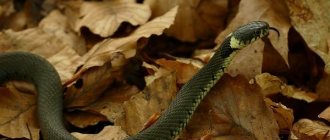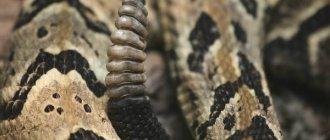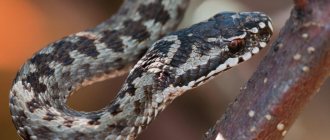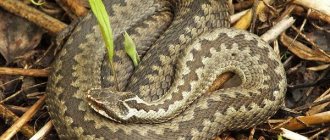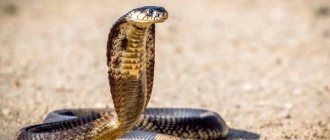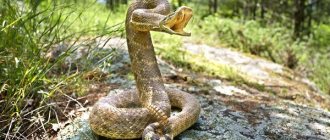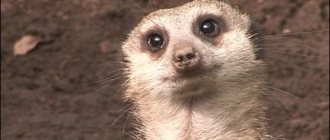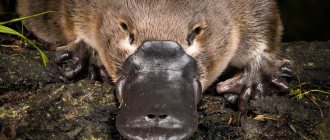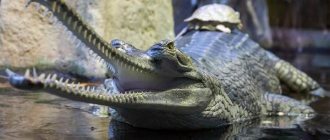Types of pythons and description
Answer to the question: “Is a python snake poisonous or not?” - we already found out. Now let's talk about the types of pythons.
Reticulate
The reticulated python is one of the longest snakes in the world and lives in Asia. Most often, the length of a python varies from 4 to 8 m, but there is a record specimen that reached a size of 12.2 m. This python lived in a zoo. Weight is 170 kg; individuals weighing 270 kg are less common. It is considered the only species that can even eat humans.
The color is complex, from light yellow to brown. There are brown, round, diamond-shaped spots along the back; a dark brown stripe of triangular spots protrudes on the sides. There is a rainbow tint on the skin. And from the eye to the edge of the mouth there is a black stripe.
They are nocturnal and feed on various species of birds and mammals.
brindle
A non-venomous snake that reaches large sizes. Actively used and purchased for zoos and circuses. The length of the tiger python can be 8 meters. Females are generally heavier and longer than males. This species lives in South and Southeast Asia. The lighter type of pythons lives in India, Sri Lanka, Nepal, and Bhutan. And dark tiger pythons are common in Thailand, Vietnam, Laos, the Malay Peninsula, and also Indonesia.
A description of the python snake will help to better recognize its subspecies. The tiger python is yellowish-brown in color with a mosaic pattern of dark brown spots.
Active in the evening and at night.
White-lipped
Distributed on islands in the western Pacific Ocean. Often found on the island of New Guinea. The size reaches from 1.2 to 1.8 meters. Females 2 meters long can also be found less frequently. Like most pythons in nature, they are very aggressive.
Eating habits
Large python species prey primarily on mammals, lizards and birds; smaller species also eat rodents, amphibians and reptiles. Black-headed pythons can hunt venomous snakes. Burmese pythons cause serious problems in the South Florida ecosystem, as this invasive species feeds on young crocodiles, birds, small mammals (some of which are already endangered) such as swamp rabbits, bobcats, raccoons, opossums and foxes.
Photo: David Clode
Pythons have a good sense of smell and vision, and most can also sense heat. The pits located between the scales of the lips have receptors sensitive to infrared radiation, and allow snakes to “see” the thermal shadow of mammals and birds even on the darkest night. These reptiles immobilize their prey with blows and bites, which are usually followed by suffocation.
Pythons have four rows of backward-curved teeth on the maxilla and two rows of teeth on the lower jaw, which they use to capture, hold and move prey into the esophagus. When swallowing prey, pythons secrete mucus containing harmless traces of venom proteins.
Character and lifestyle of the snake
Pythons skillfully climb trees and are also good swimmers. Travel speed 3-4 km/h. They have a good sense of smell.
They are nocturnal, and pythons see much better at dusk. And due to the cool temperature, they feel more strongly the thermal radiation from their victims. Attacks with a sharp throw towards the victim.
First, the python grabs the prey with its teeth and strangles it, and then swallows it. It takes them several days to weeks to digest food.
Appearance and anatomical features
Pythons are impressive snakes in everything from their six rows of razor-sharp teeth and independently moving jaw to their prehensile tail, three-quarters of which securely wraps the snake around its prey during an attack.
There are hundreds of pythons with different colors and patterns, from solid to bicolor, striped, ringed, spotted and even rainbow. The appearance of unique colors is associated with the characteristics of the native geographical regions of the snakes’ habitat.
Photo: David Clode
Pythons also have several anatomical features:
- presence of two lungs. Most representatives of the serpentine kingdom lack the left lung, and the right one is elongated and expanded;
- teeth grow on the premaxillary bones;
- presence of supraorbital bone;
- the hemipenes contain vestigial bones.
What does it eat in the wild?
These snakes often feed on large or small mammals, depending on the age and size of the python itself, as well as birds.
It can be:
- monkey;
- rabbits;
- lizards;
- birds;
- rodents, such as mice and rats;
- antelope;
- wild pigs;
- other snakes.
Shedding
Young pythons shed frequently, every 2-4 weeks. Adults can molt every few months. The skin begins to peel off from the head, and then peels off from the entire torso. Signs include clouding of the python's eyes and skin. During molting, the snake does not eat anything, and it becomes more excitable.
Nutrition
Pythons are exclusively carnivorous. Various animals become prey. It all depends on the size of the snake. Small species and young snakes are content with rodents, lizards, and birds. The diet of large individuals includes monkeys, wallabies, antelopes, and wild pigs. Livestock can also become a hunting trophy for pythons.
Pythons ambush animals. The trap for prey is set up in different ways: among tall grass, in trees, partially immersed in water. The main task of the hunter is to sink his teeth into a careless animal or bird with a throw. Next, he wraps rings around it and squeezes it. The prey's breathing and blood circulation stop. The python proceeds to swallow the killed trophy.
The snake's jaws can be opened as wide as desired. This allows a large animal, such as an adult antelope, to be swallowed whole. After swallowing, the python crawls away to a place that is safe, from its point of view. Moves on to digesting lunch. Zoologists say that snakes of this genus can go without food for up to one and a half years.
Pythons prey on herbivores and predators of various types and sizes. In areas where crocodiles or alligators are found, even these reptiles can be strangled and swallowed. But there is another side to the coin. Snakes themselves suffer from predators. In Australia from the same crocodiles, in Africa from big cats, jackals, large birds and other predators.
National Geographic magazine reported in June 2022 about a tragic incident in Indonesia. A python attacked a 54-year-old woman working in her garden. The fate of the peasant woman turned out to be sad. A year earlier, in the same places, a reticulated python attacked a young man and swallowed him.
Reproduction
Pythons are ready to breed when they reach 5-6 years of age. It occurs from the beginning of autumn to the end of winter. With the help of pheromones, the female communicates her readiness to reproduce. The male finds her by smell.
After mating, after 80-90 days, the female lays approximately 100 eggs, but more often there are no more than 60. At this moment, the snake’s body temperature rises by 12-15 degrees. They guard the clutch and do not eat anything.
After 2-3 months, the cubs appear, ranging in length from 17 to 70 cm.
Who is bigger: python, anaconda or boa constrictor
Undoubtedly, the python, the boa constrictor, and the anaconda are large animals, but many researchers, and even ordinary people, are interested in which of them is larger. The average parameters of pythons are 7-8 meters, boas - up to 6 meters, and an adult anaconda can grow up to 11 meters in length, gaining a weight of about 250 kg.
Find out more about the above types of pythons such as royal, tiger, reticulated, white-lipped, hieroglyphic, green tree, carpet.
Thus, we can assume that it is the largest snake on the planet, of course, if you do not take into account unofficial data about the caught python, 12.2 meters long.
Nuances of keeping at home
Now many people keep pythons not only in zoos, but also at home.
Dimensions and arrangement of the terrarium
The size of the terrarium depends on the size and variety of the python. Larger individuals will need a lot of space:
- The perimeter of the home should be 2 times larger than the snake itself.
- The walls should be made of plastic, glass or wood.
- The thickness of the walls must be carefully selected so that the python cannot break through them.
Optimal temperature and humidity
During the day, the temperature in the terrarium should be 26-30 degrees, and at night 23 degrees. At night the heat source is turned off.
Air humidity is about 90%.
How and what to feed your pet
You can feed a python with mice, hamsters, rats, chickens, and rabbits. Young individuals are fed once every 5-7 days, and adults - once every 10-14 days. To avoid injury to the python, it is better to feed small animals that have already been killed.
In winter, the snake feeds much less frequently.
Habitat
Different subspecies of pythons live in different habitats. Most of them are terrestrial, and some, such as the green python (Morelia viridis) of Australia and New Guinea, lead a predominantly arboreal lifestyle. There are also species that prefer arid deserts. Other species of pythons call tropical rivers and swamps their home. Terrestrial species regularly crawl near water and are good swimmers, but they hunt and feed almost exclusively on land.
Despite their large size, some pythons survive successfully in urban and suburban areas, where they are prized as excellent rat catchers.
Is it worth maintaining - all the pros and cons
Pythons are noble animals with amazing colors. Therefore, there are many people who collect them.
- Pythons are quite calm animals, some of the species are tame, for example, tiger and reticulated.
- Almost no smell.
- They don't make nasty sounds.
- They are not at all slippery to the touch, as many are accustomed to thinking.
- They do not need to be fed every day, only once every 1-2 weeks.
If you have no fear of snakes, then keeping a python will not be difficult for you. Caring for them is not that difficult.
Save Status
Many species are not of concern. In some areas of Florida, fish and wildlife commissions even conduct annual snake removal programs to reduce the numbers of pythons and other invasive reptile species, and issue hunting permits to qualified trappers.
On the other hand, pythons have been in great demand for centuries, hunted for their valuable skin and meat. Some parts of their bodies were used to prepare various traditional medicines. Overkill has resulted in some species being listed as endangered, namely the Indian and Burmese pythons. Even though the Burmese python is listed as a protected species in Hong Kong, China and Thailand, it is still hunted illegally on a large scale.
Characteristic
The python is a large non-venomous snake. This is a very dangerous predator. Its body can reach sizes of 7.5 meters. The largest representative is the reticulated python.
These reptiles are inactive. They prefer warm climatic conditions and temperatures not lower than 25 degrees. These snakes are capable of climbing trees and swimming. It is for this reason that the list of their prey is very long.
The python is a relative of the boa constrictor . But it differs from it in both external and internal features. Zoologists count 9 genera of these reptiles, and each of them has several varieties. In total, scientists studied 41 species of this dangerous, large and beautiful snake.
The classification by gender looks like this:
- The genus Leiopython has 6 species.
- The genus Apodora includes only 1 species.
- The genus Broghammerus has 2 species.
- There are 2 species of blackheads.
- Australian dwarfs include 4 varieties.
- The ringed species includes only 1 subspecies.
- Australian diamondbacks have 12 species.
- Aquatic include 3 types.
- And 10 species of real pythons have been studied.
There is also information that a couple of species have already become extinct. The Australian dwarf species is best suited for captivity or terrarium keeping. And all because of their size: weight is approximately 200 grams, and body length is 50 centimeters.
There are serious reasons to consider the python a dangerous snake, but they have no poison.
Where does the reticulated python live?
Photo: Reticulated Python Snake
The python prefers tropical and subtropical climates and likes to be near water. It originally lived in tropical forests and swamps. As these areas become increasingly scarce as a result of clearing, the reticulated python begins to adapt to secondary forests and agricultural fields and live very closely with people. Increasingly, large snakes are found in small towns, from where they have to be relocated.
In addition, the reticulated python can live near rivers and can be found in areas with nearby streams and lakes. It is an excellent swimmer that can reach far out to sea, which is why the snake has colonized many small islands within its range. In the early years of the 20th century, the reticulated python is said to have been a common visitor even to bustling Bangkok.
The reticulated python's range extends across South Asia:
- Thailand;
- India;
- Vietnam;
- Laos;
- Cambodia;
- Malaysia;
- Bangladesh;
- Singapore;
- Burma;
- Indonesia;
- Philippines.
In addition, the species is widespread in the Nicobar Islands, as well as: Sumatra, the Mentawai island group, 272 islets of Natuna, Borneo, Sulawesi, Java, Lombok, Sumbawa, Timor, Maluku, Sumba, Flores, Bohol, Cebu, Leyte, Mindanao, Mindoro, Luzon, Palawan, Panay, Polillo, Samar, Tawi-Tawi.
The reticulated python dominates tropical rainforests, swamps, and grassland forests, at altitudes of 1200-2500 m. Temperatures required for reproduction and survival should range from ≈24ºC to ≈34ºC with plenty of moisture available.
Distribution, habitats and lifestyle
The species of snake in question is widespread in Southeast and South Asia. The python's habitat covers the territories of Burma, India, Laos, Thailand, Vietnam, Cambodia, Malaysia, Indonesia, Singapore, the Philippines, etc.
Where the reticulated python lives, tropical forests and woodlands grow. You can also meet these reptiles on mountain slopes. There is a known case when a snake was found in Java, at an altitude of up to 1200 meters above sea level.
The python mainly has a terrestrial lifestyle, but it also climbs trees quite well. It prefers damp areas and often settles along the banks of rivers and other bodies of water. Swims well and can also swim into the open sea. It mainly hunts at night and at dusk; during the daytime it is found in shelters (for example, in caves).
Can a python swallow a person?
The largest representatives of the python family can actually eat a person, which has already been confirmed. The last of them dates back to 2022, because not so long ago on the island of Sulawesi (Indonesia), a snake 8 meters long swallowed an adult woman.
Last year, in the same area, a 7-meter reptile killed a man in the same way. Moreover, several years earlier similar attacks on a woman and child had already been reported, but, fortunately, the latter was saved.
In a word, you should not take risks communicating with such animals, no matter how long they are.
Important! When going on an excursion to these regions, you should not take your pets with you, because it is because of them that snakes often attack not only local residents, but also individual tourists.
Main features
No matter how strange it may sound, the python has legs . Of course, not the same as in humans or animals, but rudimentary hind limbs. All that remains of full-fledged limbs today looks like small claws. In science they are called anal spurs. And this is due to their location.
In addition to paws, each species of this snake has rudiments of the pelvic girdle. These animals have two lungs, just like every human and mammal. Other snakes (black mamba or viper) have only one lung - the right one, which is extended along the body.
The python also has teeth that are located on the submandibular bone. These reptiles also have supraorbital bones. All mothfish, lizards or snakes have a specific sexual organ called the hemipenis. In this species of reptile, it has rudimentary bones that completely prevent the genital organ from retracting. During the mating season, male reptiles rub such bones against females.
How to Avoid a Bite
In order not to encounter pythons in the wild, you should find out in detail from the guide or guide all the details about the dangerous fauna that a tourist may encounter when visiting certain places.
In captivity, animals are usually peaceful, and show aggression only when they feel pain, danger or hunger. In all cases, bites occur as a result of inept handling of the animal.
Therefore, novice terrarium keepers are recommended to first gain experience in dealing with snakes by consulting with herpetologists or experienced lovers of keeping pythons in captivity. If you handle the animal correctly, the risk of harm from its teeth is minimal.
Giant anaconda
The largest snake can be considered the anaconda (giant or green) up to 10 meters long. Its weight can reach up to 220 kilograms.
In the USA (New York), the terrarium of the Zoological Society contains the largest anaconda weighing 130 kilograms and approximately 9 meters long. The largest individual in terms of length was recorded in 1944. Its length was 11 meters and 43 cm. It was measured by a geologist who was looking for gold in the Colombian jungle at that time. The generally accepted record today, listed in the Guinness Book, is 12 meters. In fact, today the average length of this species of snake is 6 meters. In nature, larger individuals are extremely rare.
"Reptilife" for python health
The vitamin and mineral complex “Reptilife Powder” will help maintain the health of the snake and provide it with the necessary vitamins and microelements, including during active growth or molting. The food supplement was created specifically for reptiles, taking into account their needs, contains vitamins A, K3, C, D, E, and B vitamins. It will help cope with vitamin deficiencies, normalize metabolism, and recover from illness. It is convenient to use the additive when the python has already switched to feeding on defrosted food. It is enough to lightly moisten the rodent carcass and roll it in vitamin powder.
